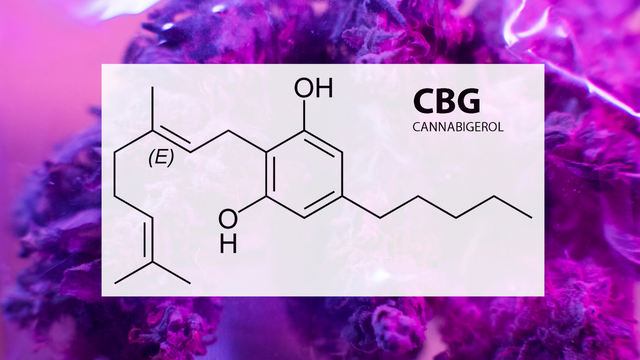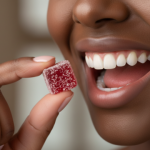Are you at least 21 years of age or hold a valid medical marijuana card?
Daily Specials
{{ special.title }}
{{ special.description }}
*{{ note }}EARTHMED BLOG

What is CBG (Cannabigerol)?

Cannabigerol (CBG), also referred to as the ‘mother’ of all cannabinoids, is a minor cannabinoid that exists in all cannabis plants and flower. Actually, we wouldn’t have THC, CBD, or many other cannabinoids if it wasn't for CBG. And this is because CBG is the decarboxylated form of cannabigerolic acid (CBGA), making it a parent molecule from which other cannabinoids are derived, including THC and CBD.
A History of CBG
If CBG is so important, then why are we only hearing about it now? After all, we’re all well aware of THC and its psychoactive effects. And as CBD’s benefits have become recognized, information about it and its products are now more prevalent as well. So why haven’t CBG properties been studied?
Well, actually, CBG has been around for thousands of years. In ancient India, CBG was used to help with appetite and phlegm production, according to the Sushruta, a medical text written by Shusruta in the 6th Century. In modern times, CBG was first synthesized in 1964 by Raphael Mechoulam, Yechiel Gaoni, and Yuval Shvo.
Since then, research on the CBG cannabinoid has been dormant until recently. And that’s because it’s difficult to perform a CBG test since it exists in only trace amounts in most strains. The amount of CBG found in most cannabis flower is usually around 1%, compared to more popular cannabinoids, like THC and CBD, which usually have concentrations between 10 to 30%.
What is CBG?
The reason for the small concentrations is that CBG is different from most cannabinoids. CBG is the initial raw form of all cannabinoids before they’re synthesized. CBG in the plant's cannabis bracts and leaves slowly converts into some of the more recognizable cannabinoids.
By the time a given cannabis plant has grown to maturity, most of the CBG cannabinoids have been converted to other cannabinoids, like THC or CBD. In order to better study CBG, cultivators have been creating strains with increased concentrations of CBG.
CBG Strains with High Concentrations
While all hemp contains some quantities of CBG, the following strains were bred to have CBG in high amounts, by comparison. Of course, this will always vary depending on the brand and how they’re grown. In no particular order, the strains with the highest concentrations of CBG are:
- White Widow
- Stem Cell CBG
- White CBG
- Silver Haze CBG
- Desert Snow CBG
- Sour G
- Jack Frost
- Superglue
- Madras CBG
- Biscotti
What is CBG Good For and What are the benefits of CBG?
The development of these strains has helped researchers further study Cannabigerol and the different CBG effects. And they’ve found that CBG could be especially useful for its anti-inflammatory effects. Because it helps with inflammation, there is also promising research that indicates CBG can help promote brain health by reducing cell damage. CBG’s effects on certain bacteria in the gut can also help reduce inflammation and improve gut health.
CBG has also been shown to have antibacterial effects. While methicillin-resistant Staphylococcus aureus (MRSA) is a bacteria resistant to antibiotics, a recent study indicates that CBG has had promising effectiveness against MRSA. As CBG continues to be studied, we are sure to learn more about the human health benefits of CBG.
Does CBG Get You High?
One of the benefits of CBG is that we can study it more because it does not have any psychoactive effects, like THC. Similar to CBD topical creams, gummies, and vapes, CBG products make you feel relaxed and comfortable. The lack of psychoactive properties makes it legal and easier to buy CBG and study it. Since CBG binds to the same CB1 and CB2 receptors in the endocannabinoid system as THC does, it keeps THC from being able to bind to those receptors and can inhibit or even counteract the psychoactive and euphoric feelings caused by THC.
CBG Vs. CBD
Because CBD and CBG are so similar, the question of what makes CBG different is often raised. Both CBG and CBD are both cannabinoids that have been shown to have anti-inflammatory, antimicrobial, and neuroprotective properties. The main difference between the two is that CBG is a minor cannabinoid, while CBD is a major cannabinoid. This means that CBD is found in higher concentrations in most strains compared to trace amounts of CBG. But that makes sense because, as previously mentioned, CBD is derived from CBG, and most of the CBG a young hemp plant has will be converted to other cannabinoids, including CBD, by the time the plant has reached full maturity.
The Bottom Line
Although it is relatively new, CBG is already showing promising anti-inflammatory and antibacterial effects that could prove to be beneficial to human health. There are already potential relationships between weed and menstruation, blood pressure, and other common physical ailments, so it wouldn't be a surprise if CBG demonstrated similar benefits. Similarly, while there is support for medical marijuana and cancer patients, the relationship with CBG remains to be seen.
As the research goes on, we are sure to see more information on the benefits of CBG become available, as well as an increase in different CBG products. As always, be on the lookout for new information on CBG, and stay safe!
{{ locations[0].name }}
{{ locations[0].address }}{{ locations[0].city }}, {{ locations[0].state }} {{ locations[0].zip }}
{{ locations[0].phone }}
Hours
Sun: {{ locations[0].hours_recreational.Sunday }}Mon: {{ locations[0].hours_recreational.Monday }}
Tue: {{ locations[0].hours_recreational.Tuesday }}
Wed: {{ locations[0].hours_recreational.Wednesday }}
Thu: {{ locations[0].hours_recreational.Thursday }}
Fri: {{ locations[0].hours_recreational.Friday }}
Sat: {{ locations[0].hours_recreational.Saturday }}
{{ locations[1].name }}
{{ locations[1].address }}{{ locations[1].city }}, {{ locations[1].state }} {{ locations[1].zip }}
{{ locations[1].phone }}
Hours
Sun: {{ locations[1].hours_recreational.Sunday }}Mon: {{ locations[1].hours_recreational.Monday }}
Tue: {{ locations[1].hours_recreational.Tuesday }}
Wed: {{ locations[1].hours_recreational.Wednesday }}
Thu: {{ locations[1].hours_recreational.Thursday }}
Fri: {{ locations[1].hours_recreational.Friday }}
Sat: {{ locations[1].hours_recreational.Saturday }}






